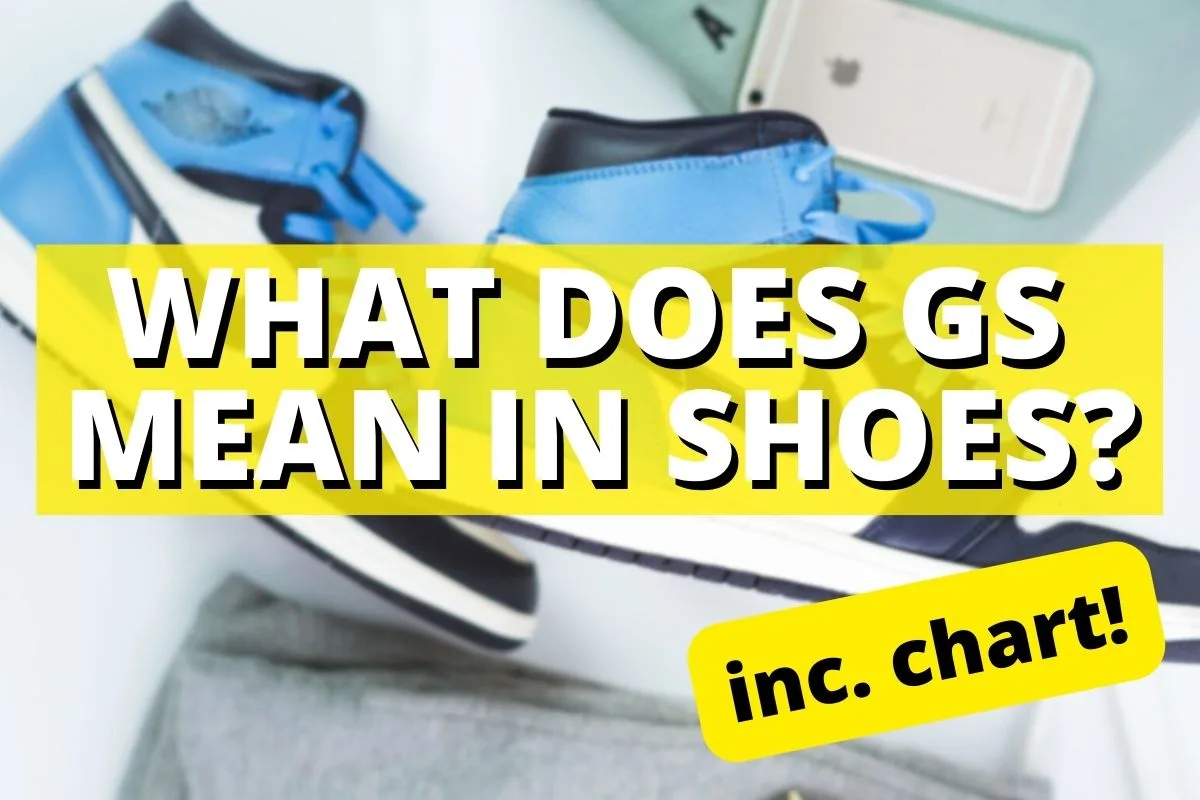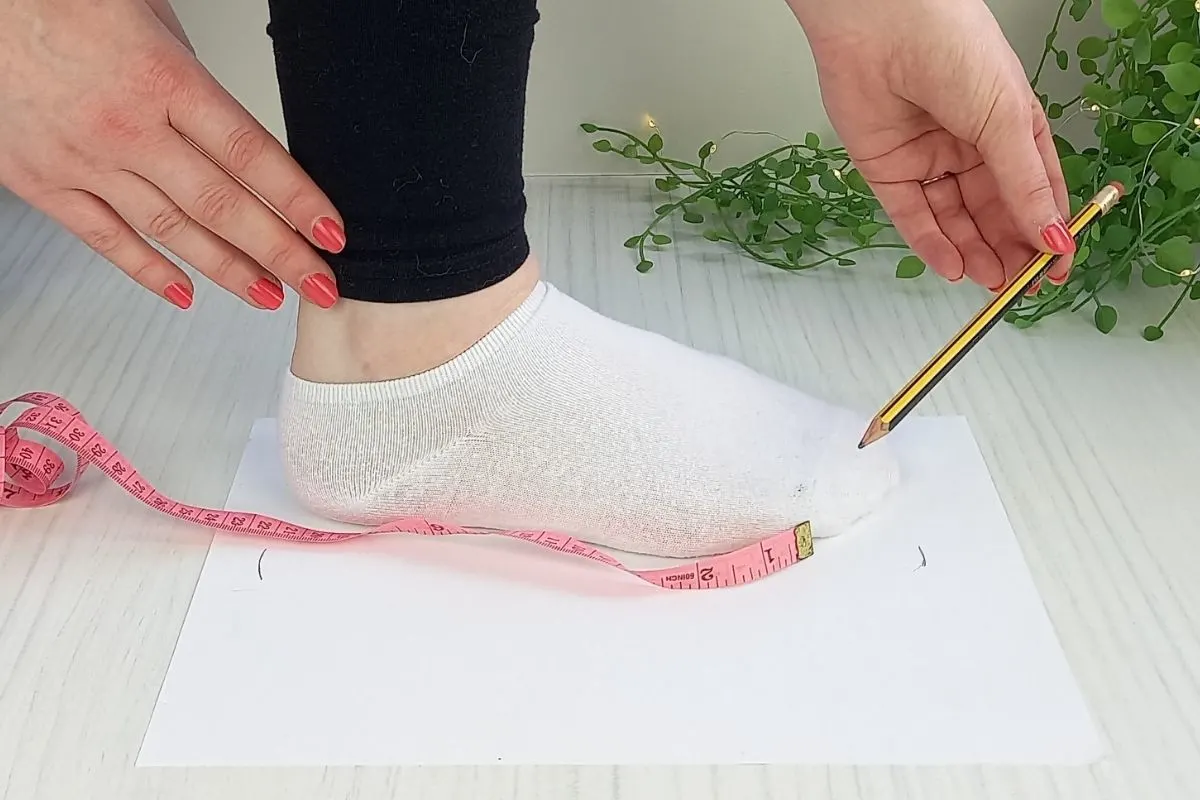When buying a pair of shoes, the choices are often unlimited. The number of available shoe choices can often be overwhelming, especially when confusing acronyms like GS come into the mix, further complicating your shoe choice. What does GS mean in shoes?
Regarding shoes, GS simply refers to “Grade School.” This means the shoe is designed to fit a child’s foot at Grade School-age. GS doesn’t refer to one size of shoe but refers to a range of shoe sizes within which your Grade School-aged child will be able to find their size.
The GS acronym is one of many shoe size categorizing acronyms pioneered by Nike. It is used widely in their Air Jordans range. The acronym has since become widely adopted across many other brands. Several other acronyms help to categorize shoes into different size ranges. This ensures that buyers can buy the perfect size shoe for themselves and their children.

What Does GS Mean In Shoes?
The acronym “GS” is one of many acronyms for categorizing shoes. The GS acronym was initially launched by Nike within their Air Jordans shoe range. The acronym simply means “Grade School.” This means that any shoe with the acronym “GS” on it will fall within the range of the average expected size of a child at grade school age.
Grade School shoes are designed specifically to fit the feet of children attending grade school, as these children will be a specific age, and their feet will fall within the average range of children at that age. This is particularly useful when looking for shoes for your child, and there is an enormous range of sizes to choose from.
A Grade School specification for a shoe is very useful in helping you find the best possible size shoe for your child’s feet. It’s important to remember that the “GS” acronym doesn’t refer to a single shoe size but to a range of shoes within a separate size chart. For example, a GS size 6 will naturally be a completely different size from an adult size 6 shoe.
Regarding the Nike Air Jordan shoe range, the GS acronym was created to distinguish the adult line of shoes from the children’s replicas of the same. The GS range of shoes comprises re-engineered versions of many of the popular shoe silhouettes originally designed for adults.
To create the GS range, several of the popular adult silhouettes were completely re-engineered to allow them to be made into smaller sizes. The resultant shoes are miniature versions of the original adult shoes, carefully proportioned to maintain their original design as far as possible.
You may also like this time-saving post, especially if you have kids: How To Lace Shoes So They Slip On – 3 EASY Ways
The Grade School versions of these shoes often feature interesting child-friendly designs and color combinations that are generally unique to the children’s range of shoes.
It’s important to remember that despite the shoe size being changed to suit children, the GS range of shoes has not necessarily considered all factors of a shoe’s fit. Certain aspects such as foot length and arch height have not been fully considered. The same goes for how different styles of shoes will fit differently on the feet of boys and girls.
As a result, measuring your child’s foot and fitting the shoes in-store whenever possible is always important. This will allow you to ensure a perfect fit and optimal comfort for the wearer of the shoe. I have included a GS shoe size chart later in this post if you would like to give this a go at home instead.
After Nike pioneered the GS acronym for their range of shoes for Grade School-age kids, many popular shoe brands adopted the same naming conventions for similar-sized shoes. This system of classifying shoes according to their relevant acronyms is particularly useful when a brand has a wide range of size options.
By using acronyms such as GS to distinguish a certain category of shoes from the rest, you can find the specific size shoe you need with relative ease.
GS Shoe Size Chart
Here is a GS shoe size chart that you can use to determine your child’s foot size:
| US | UK | EUR | CM | INCHES |
|---|---|---|---|---|
| 3.5 Y | 3 | 35.5 | 22.5 | 8.9 |
| 4 Y | 3.5 | 36 | 23 | 9.1 |
| 4.5 Y | 4 | 36.5 | 23.5 | 9.3 |
| 5 Y | 4.5 | 37.5 | 23.5 | 9.3 |
| 5.5 Y | 5 | 38 | 24 | 9.4 |
| 6 Y | 5.5 | 38.5 | 24 | 9.4 |
| 6.5 Y | 6 | 39 | 24.5 | 9.6 |
| 7 Y | 6.5 | 40 | 25 | 9.8 |
Other Shoe Acronyms & Their Meanings
Just as the GS acronym stands for “Grade School,” there are various acronyms used by Nike (and many other shoe brands) that help classify a certain range of shoes for individuals of a specific age range. This makes the process of finding shoes for your children – or yourself – significantly easier, especially if the brand has a wide range of shoes.
Especially with young children, the acronyms for shoe sizes categorize the shoes according to the child’s age group. This is associated with the average size of a child at that age. However, various factors can cause a child’s feet to be larger than the average child of the same age.
Genetics will naturally play a major role in the size of a child’s feet. As a result, it’s important to always measure the child’s feet to ensure a perfect fit.
There are many acronyms used by shoe companies to describe certain ranges. Most of them are to do with the size range of the shoes. However, there are other acronyms used that have nothing to do with the shoe size. When it comes to children’s shoe sizes, brands such as Nike use specific acronyms for size ranges to ensure that the size is obvious to the buyer of the shoe.
Some of the other acronyms used for shoe sizes include:
- Y: Shoes with the Y acronym generally have this letter to indicate “Youth” or “Years.” Either way, this acronym indicates that the shoe is designed for use by children. The “Youth” designation will indicate a range of shoes designed for children of a certain age, whereas the “Years” designation will indicate the specific age of the child for whom the shoe is designed to fit.
- K: Some brands will use the “K” acronym to indicate that the shoes are designed to be worn by a “kid.” While not all brands use this letter for their shoe sizing, it can effectively show the range of sizes to which the shoe belongs.
- N: The letter “N” on a shoe will indicate that the shoe has a narrow fit. This is particularly useful for people with narrow feet who find conventionally sized shoes are simply not a good fit. Wearing any shoes that are too wide for your feet can cause many problems, so it’s important to find the best fit for your specific foot size.
- M: If a shoe has the letter “M” next to its size, it has a medium-width fit. This is a good fit for somebody who finds narrow shoes too tight but wide shoes too wide.
- W: The letter “W” next to your shoe size will indicate that the shoe has a wide fit. Not everybody can wear a shoe with a wide fit, and it is only recommended for those with particularly wide feet.
- R: An “R” designation for your shoe means regular width. This is the most common shoe width and is highly recommended for anybody with ordinary, regular-sized feet.
- TD: If the shoes you are viewing have the letters “TD” on the size label, this indicates that the shoes are designed for toddlers. Shoes within the toddler range will have different sizes from those in the Grade School range, for example. There will also be different designs available. The acronym “TD” allows manufacturers to indicate to consumers with ease who the shoe is designed to fit.
- GG: The “GG” acronym means that the shoe is designed specifically for Grade School Girls. This shoe category will often feature designs targeted specifically towards girls of a Grade School-age.
- BG: Similar to “GG,” a “BG” designation for a shoe means that the shoe belongs to a category specifically targeted toward boys of a grade school age. This type of shoe will generally have colors and designs that appeal to boys. It will also consider the average size of boys’ feet at that age, including the width.
- OVO: OVO is another acronym used by Nike to indicate a range of Jordans that form part of a collaboration with OVO – Drake’s record label named October’s Very Own. Within the range are two colorways of the Jordan 10s and two of the Jordan 12s.
- PRM: PRM is used to indicate the range of Jordans designated as “Premium.” The materials from which these shoes are made are from the higher end of the quality spectrum. “Premium” Jordans are also usually released in more subtle colors such as grey, olive, tan, and black instead of the brighter colors usually associated with the brand.
- HC: The acronym “HC” refers to shoes designed specifically for use on a Hard Court. “HC” directly refers to “Hard Court.” These shoes are more durable than other shoes, as they need to withstand harder and more abrasive surfaces.
- OG: An “OG” designation for your Air Jordans has nothing to do with the size range of the shoes. This acronym indicates that the shoes are from one of the original releases of that specific shoe design.
The OG Air Jordans will usually feature different colorways than the later releases, despite being the same model. This use of unique colorways helps distinguish the OG shoes from the run-of-the-mill versions. It helps make the original release shoes appear more special and significant.
For those unfamiliar with sneaker terminology, the term “colorways” refers to the pattern and arrangement of colors on a specific sneaker. This generally refers to the actual design of the sneaker, and sneakers within a certain range can feature several colorways.
You may also like: What Does H Mean In Shoe Size? (Size Chart)
Can People Of All Ages Wear GS Shoes?
While the Grade School size range of shoes is designed for feet the size of Grade School children, the designs are often almost identical to the original adult shoes. As a result, if you happen to be a teenager or adult with small feet, there’s no reason why you can’t wear something from the GS range.
Of course, you can only wear them if your feet are small enough to fit into them, but there are many adults with feet small enough to fit into Grade School size shoes. If this is the case, you will save significant money. Designer shoes made for Grade School children will cost significantly less than those made for adults, so the potential exists for you to find great shoes at a bargain price.
You must fit the shoes properly and measure your feet to ensure a perfect fit. You must always avoid wearing shoes that are too small for your feet, as this can cause a host of problems.
Measuring Your Child’s Feet For Shoes
It’s important to measure your child’s feet properly before purchasing shoes. To do this you will need a ruler, pencil and paper, a flat surface, and a wall. Once you have everything you need, get your kid to stand on the flat surface with their back to the wall.

The child’s heels must be parallel to the wall. Your next step is to measure from the wall to the child’s longest toe. The ruler must be placed inside the foot to obtain this measurement. Once you have the measurement, you can use Nike’s shoe sizing tool to determine the best shoe size to purchase (or you can use the size chart I provided earlier in the post).
Bear in mind that many people have feet of two different sizes. There is often a difference of around half a size between the two feet. If this is the case with your feet, you should purchase shoes in the size of the bigger foot to ensure that they will fit properly.
Other Considerations For Children’s Shoe Sizes
The possibility exists that your child’s feet could fall between two of the sizes within the Grade School range. If this is the case, you should then opt for the larger size between the two. This will ensure that the child’s feet are always comfortable.
However, you should also consider the shoe type. Certain shoe types are better able to expand to fit your feet than others are, which is something to consider when choosing a shoe size.
Conclusion
There are several acronyms used for specifying shoes in general. Many of the acronyms are targeted towards defining size categories for children’s shoes to help people find the best shoe for the feet of their constantly growing children. Some other acronyms define a specific limited edition range of shoes.
For more footwear size guides, check out:
Are Vans Good For Wide Feet? (Size Guide FAQs)
Are Converse Good For Wide Feet? (Size Guide FAQs)
Do UGGS run big? Ultimate Size Guide & Real Review
Do Doc Martens Run Big? – A Sizing Review With Photos
Converse Sizing: Do Converse Run Big or Small? (FAQs/ Chart)

Lorna is a footwear geek and the founder of Wearably Weird. She created a YouTube channel in 2021 for fellow footwear fanatics, dedicated to detail-rich footwear reviews and info. She has a fashion media qualification (awarded in 2011).
